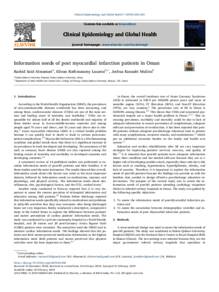Document
Information needs of post myocardial infarction patients in Oman.
Identifier
DOI: 10.1016/j.cegh.2019.02.006
Source
Clinical Epidemiology and Global Health. v. 7, 4, p. 629-633
Contributors
Lazarus, Eilean Rathinasamy., Author
Muliira, Joshua Kanaabi., Author
Country
Netherlands.
Publisher
Elsevier B.V.
Gregorian
2019-12-01
Language
English
English abstract
According to the World Health Organization (WHO), the prevalence of non-communicable diseases worldwide has been increasing, and among these, cardiovascular diseases (CVDs) are one of the most serious and leading cause of mortality and morbidity.1 CVDs are responsible for almost half of all the deaths worldwide and majority of these deaths occur in low-to-middle-income countries and among people aged 70 years and above, and 15 years and above due to obesity.2 Acute myocardial infarction (AMI) is a critical health problem because it can quickly lead to death or leads to serious post-acute-period complications.3,4 Myocardial infarction (MI) is a life-threatening condition and global trends show that there is a significant increase in its prevalence in both developed and developing. The precursors of MI such as coronary heart disease (CHD) are also reported among the leading causes of mortality and morbidity in developed countries and developing countries.
ISSN
2213-3984
Category
Journal articles

